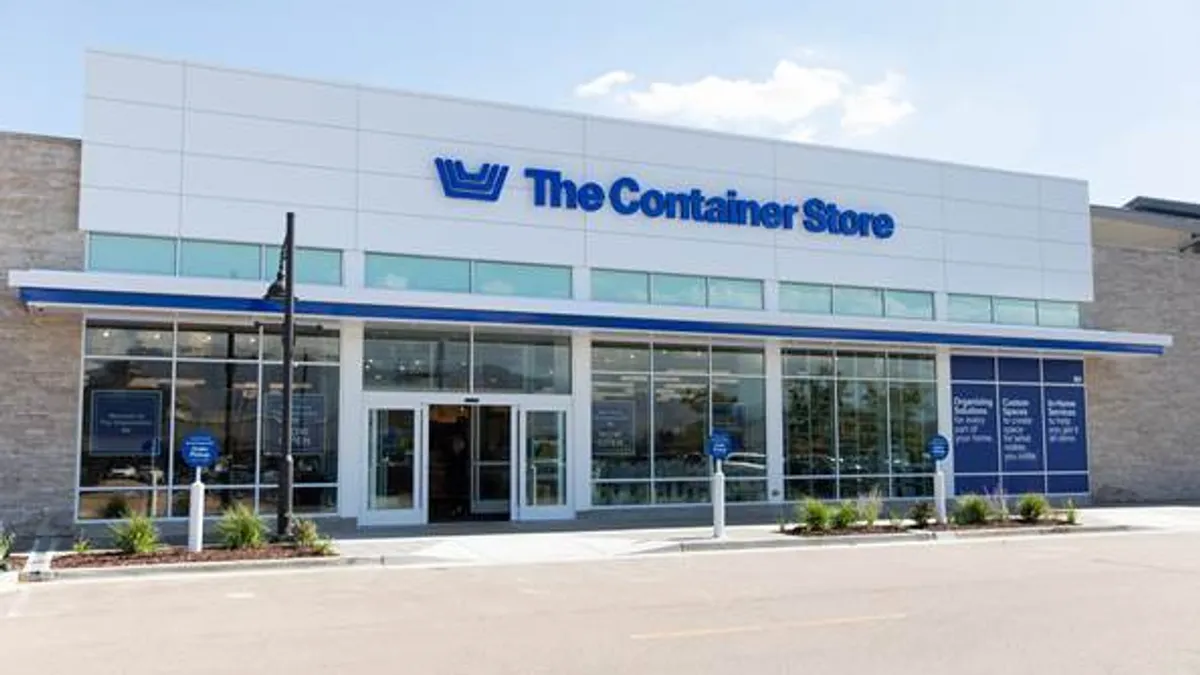When Mary Dillon joined Ulta in July 2013, the retailer had just raked in $2.2 billion in net sales for 2012, on the back of several years of strong net sales growth.
"Ulta has enjoyed tremendous success for the past several years, executing a well-defined strategy. And that includes accelerating store growth, introducing new products, services and brands, enhancing our loyalty program, broadening our marketing reach and increasing our digital focus, including ulta.com," Dillon said on her first earnings call as CEO. "I don't plan to make any radical changes to this strategy, but rather I plan to expand and build upon this solid foundation."
Dillon did just that. Under her leadership, net sales growth would continue, maintaining a 20% or higher growth rate from 2013 to 2017. In 2018, growth slowed to 14%, and in 2019, it was 10%. But Dillon was also at the front of a larger shift at the retailer, from a regional mass beauty player to a company that offered premium beauty brands as well.
"With consumers shopping high and low cosmetics, Ulta is actually even better positioned I believe than Sephora. Ulta is the number one destination for teens right now," Erin Schmidt, senior analyst at Coresight Research, said in an interview, citing Piper Sandler's annual teen survey. Coresight Research estimates that Ulta makes more in revenue now than Sephora, though it's hard to ultimately tell since Sephora doesn't divulge its financials.
"She changed their entire brand image from being a drugstore retailer into something completely different," Schmidt said.
Dillon made Ulta an experiential destination, multiple experts said, and brought more professionalism to not only the lineup of brands but also the salon services business. Stephanie Wissink, a managing director at Jefferies, still remembers a moment about two years after Dillon took over that foretold that shift at the retailer.

"I remember being at an event when Mary walked into the room, and I watched the head of Estée Lauder, L'Oréal, Elizabeth Arden, Bare Minerals — I watched all of them turn and look," Wissink said. "And I remember thinking, 'Something is changing at Ulta. Mary is changing things at Ulta.'"
And change they did — mostly for the better. In her eight years at the helm, net sales, operating income, net income, comps and store count increased every year except for the last, which was marked by mass store closures as the pandemic took hold and forced businesses to temporarily shut. Even so, net sales in 2020 were down about 17%, hardly catastrophic considering a global health crisis that bankrupted many companies.
By almost any measure, Dillon has been a solid leader for the beauty retailer and was one of only a few female CEOs, even in the female-focused beauty space. The company will undoubtedly miss a lot about Dillon, but the possibilities are still beautiful for Ulta.
From drugstore to destination
Analysts knew this day was coming, but it still was a surprise to many when Dillon announced her plans to step down in March this year, including JPMorgan analyst Christopher Horvers.
"Mary, you're still young. You own a lot of stock in the company and the business is clearly poised to recover here in 2021. So, I think a lot of investors look at the announcement and think this is at least a year early," Horvers said on a call in March after the CEO announcement. "Can you share your thoughts on why — further, why now?"
Dillon didn't give much away, other than that it felt like the right time and that her successor Dave Kimbell (who officially took over the first week of June) was ready. Kimbell's been in the C-suite at Ulta the whole time Dillon has and helped her build Ulta's brand to be a destination for discovery. They created the 21 Days of Beauty event, built up the loyalty program, and — a crucial piece to Wissink — Dillon convinced premium beauty brands to sell at Ulta.
"I think to Mary's credit she has figured out a way to establish and reinforce those relationships to reassure Estée Lauder and L'Oréal Luxe and these premium brands in beauty that it's okay to coexist in an environment with Morphe and Makeup Revolution and Elf and CoverGirl and Revlon," Wissink said. "It doesn't degrade the value of Estée Lauder to be in the same space as those value price brands. The same reason that H&M can fit in a shopping mall next to a Burberry or next to a Gucci store or a Louis Vuitton. Why? Because the same woman that's carrying a Louis Vuitton handbag is wearing a pair of jeans from H&M."
Dillon also introduced a space for up-and-coming brands to live, resulting in an assortment that features traditional brands in addition to indie ones, mass brands in addition to prestige. Ulta's strategy became establishing itself as the "partner of choice" for hot new DTC brands to sell through brick-and-mortar for the first time and finding innovative ways to highlight those brands in stores and online.
She was a "high-growth CEO," as Wissink calls it, raising Ulta to be a national retailer, partnering with major brands, and leading the company through a digital transformation. The store count more than doubled while Dillon was there, net sales and operating income more than tripled, and net income more than quadrupled (excluding the year of the pandemic).
E-commerce was "a fraction of a percent" when Mary arrived and will make up 25% of the business when she leaves, according to Wissink.

The pandemic also helped fuel that e-commerce adoption. According to a report from 1010data, Ulta's e-commerce sales grew 67% year over year, compared to 25% at Sephora, driven by cheaper prices at Ulta and Ulta's mostly off-mall store base. Prices at Sephora were almost 54% higher than Ulta, which made the latter more appealing to customers trying to rein in their finances during the pandemic.
The company's BOPIS sales also surged 277%, while delivery grew 49% in 2020, 1010data said. BOPIS sales grew from 8% of total online sales at Ulta to 17% of total online sales in 2020.
The company has said that omnichannel customers spend more, and Dillon knew the value loyal customers could bring. She not only built up digital operations but also the salon business — whose customers shop twice as often and spend three times as much, according to Schmidt — while improving the loyalty program's perks to create a solid foundation for the company.
Ulta invested in personalization and other data tools to grow loyalty, Schmidt said, leading to a 20 million-member gain over Dillon's tenure. During Dillon's first earnings call at the company, members had just surpassed 12 million, while in the retailer's latest earnings, members grew to 32.3 million.
Practically every piece of the business was improved under Dillon.
"She took it from a regional operator to: It's kind of a national destination," Wissink said. "And that includes everything from assortment to visual merchandising to marketing to in-store experience and services. She was really around for the engendering of those attributes."
But it's not just impressive growth and financial success Kimbell will have to replace. It's also the woman herself, whose influence went beyond the spreadsheet.
Beyond the numbers
"Mary always had the ability to command a room," Wissink said. "She was incredibly approachable. I think you could see Mary on the sidewalk and she would greet you with a hug and have a warm smile and a welcoming conversation. You would never know that she's the CEO of a multi-billion-dollar company. She's incredibly humble. And it was through her humility that she had tremendous influence."
Schmidt likewise recalled that Dillon knew "everybody by name" at an analyst event she attended. She was likable, approachable: "the kind of person everybody wanted to talk to."
That's a harder skill set to replace, and part of Dillon's legacy will undoubtedly lay beyond the economic success Ulta has generated under her leadership. As one of the most prominent female executives in retail — joined recently by the likes of Sonia Syngal at Gap and Lauren Hobart at Dick's Sporting Goods — Dillon will also be remembered as one of the first major female CEOs at a retailer.
"Her legacy as the CEO of Ulta will go beyond Ulta. You see it a little bit with the CEO of Kohl's, Michelle Gass: These are ceiling busters," Wissink said. "And they're making it possible for women across retail organizations to rise up into positions of prominence."
Even now, many women in executive positions in retail are relegated to HR roles, and while the representation of women in spaces like beauty is arguably higher than others, that final leap to the C-suite or to the top CEO spot can still be elusive. Almost as soon as Dillon joined Ulta, the representation of women on the board jumped to 50%, while the executive team also improved.
"When Mary went to assemble her executive committee, there was a tilt in that room," Wissink said.
"When you start changing the language of an organization, you start to notice a posture change."

Stephanie Wissink
Managing Director at Jefferies
Kimbell is one of four men on Ulta's executive team, and several high-ranking positions at the company are filled by women. According to Wissink, the head of e-commerce, head of stores, head of services, and the two heads of merchandising are all women. Patricia Hong, partner and managing director in Alvarez & Marsal's Consumer and Retail Group, praised the leadership team as one of Dillon's "biggest achievements."
In emailed comments, Hong said Dillon's team is "well-prepared and diverse" with more than half women and close to a quarter people of color by Hong's count.
It's well-known as an important part of Ulta's mission — in fact, one of the retailer's core values is to "champion diversity" — and Dillon has been a big part of furthering diversity and inclusion efforts at Ulta. That includes outside of the company's corporate walls.
Just this month, Ulta signed on to the Fifteen Percent Pledge, promising to have 15% Black-owned brands on its shelves, which comes on the back of wide-ranging diversity commitments made early in the year.
"Even the terminology that they use — they talk about their customers as guests. When you start changing the language of an organization, you start to notice a posture change," Wissink said. "And I think the same was true around diversity. I think she started to instill a different language around the importance of it, and all of a sudden, it became central to the DNA of the business."
The next CEO
Needless to say, Kimbell has big shoes to fill. And thanks to Dillon's transformation at Ulta over the years, the retailer has more competitors than ever.
The shift to more online spending means more competitors from the brands Ulta sells as companies try and build out their own DTC operations. Ulta's shift into prestige brands has made it a formidable competitor to Sephora, and some of the two companies' recent decisions have pinned them even more directly against each other.
Sephora, both through its Kohl's partnership and its stand-alone locations, is moving more forcefully into the same types of off-mall locations Ulta has been known to thrive in. While Ulta stole some of Sephora's thunder by announcing a shop-in-shop deal with Target a month earlier, a May 2021 Coresight Research report cited Sephora as the winner of the two, noting that 90% of U.S. consumers would be within 10 miles of a Sephora store by 2023.
In addition to expanding its off-mall presence, there's "minimal" overlap with the retailer's Kohl's shop-in-shops, meaning less chance of cannibalization. The stores are also twice as big as Ulta's Target stores, according to Coresight Research, but both retailers will likely benefit from their respective deals.
In talking through the partnership last fall, Kimbell said he sees it as another opportunity to deepen loyalty with its shoppers, thanks to the added convenience of Target. And, importantly, a way to drive customers back to its own stores. It should also help expand Ulta's footprint outside of its own store base, which has grown extensively over the years but is slowing down as the company reaches its ideal base.
"The opportunity gap in opening more stores is far, far smaller. I think they can be 1,400 on the bottom end. If they're a little over 1,200, there's not a lot of growth left from new units," Wissink said. "So it's really about maximizing the productivity of the existing fleet that you have. And then, they've just established this partnership with Target. What is that going to mean for opportunity? What does it mean for cannibalization? How did they think about acquiring new customers through that partnership? Those are all things that the new CEO coming in is going to have to resolve."
Ulta's store count has grown substantially since Mary Dillon joined
| Year | Store count | Net openings | Comps |
|---|---|---|---|
| 2020 | 1,264 | 10 | -17.9% |
| 2019 | 1,254 | 80 | 5% |
| 2018 | 1,174 | 100 | 8.1% |
| 2017 | 1,074 | 100 | 11% |
| 2016 | 974 | 100 | 15.8% |
| 2015 | 874 | 100 | 11.8% |
| 2014 | 774 | 99 | 9.9% |
| 2013 | 675 | 125 | 7.9% |
| 2012 | 550 | 101 | 9.3% |
| 2011 | 449 | 60 | 11.5% |
Source: Ulta annual filings
Store fleet is just one of the ways Sephora and Ulta have gotten more competitive over the years. In summer 2019, both companies rolled out DTC-focused initiatives: Sephora's featured end-caps highlighting up-and-coming brands and a skincare trend wall, while Ulta launched a platform called Sparked at Ulta Beauty focused on showcasing DTC brands online and in stores.
Hong believes Ulta is beating Sephora in the battle for the young consumer, including through housing those young brands. Both have strived to nab exclusive partnerships with hot new brands — Ulta's permanent and temporarily exclusive products made up 13.5% of annual sales in fiscal 2020, according to Coresight — and both are fighting to improve clean beauty offerings and the diversity of their assortment.
Ulta's Fifteen Percent Pledge came about a year after Sephora signed on as the first retailer. (However, Coresight noted that as of February, Sephora offered just nine Black-owned brands.) Clean beauty has come into focus at both through Ulta's Conscious Beauty program, which launched in July last year, and Sephora's Clean at Sephora label, which debuted in 2018.
As of February, Sephora's program had over 1,600 products (about 4% of the total assortment), Coresight wrote in its report. The analysts also noted that Ulta's program is stricter than Sephora's, but both play to consumer trends that are ever more important in the beauty space.
That alone would be enough to occupy Kimbell. Then there's the continuing question around makeup.
As the beauty industry emerges from the health crisis, some think makeup is poised for a comeback, which would be good news for Ulta, as cosmetics made up 45% of its business as of May 1, 2021. Online sales of makeup at least increased last year, as shoppers turned online to shop a category that's frequently bought in stores. Makeup — including eyes, face and lips makeup — grew 40% last year, while self-care — including hair, face and body — grew 59%, according to a 1010data report. Monthly online beauty sales surged 75% in April, 68% in May and 97% in June as stores reopened.
But there are still lingering questions about the category, and makeup is still "pretty weak," according to Wissink. The post-COVID atmosphere, in general, remains somewhat of a question mark, and despite Dillon's incredible growth at Ulta, the profitability rate of the company hasn't expanded. This, and more, will be Kimbell's job to tackle.
"He's definitely extraordinarily equipped for this role and has deep knowledge of Ulta and its strategy, so for sure I believe that he will lead the company into its future," Schmidt said. She expects an increased focus on digital — and so does Kimbell.
During the company's latest conference call, Kimbell outlined some of his priorities, which include omnichannel experiences, operational excellence, members and the company culture. At the same time, Dillon took her last conference call at Ulta to reinforce her support for Kimbell.
"His role as chief marketing officer, chief merchandising officer and president has given him a much better understanding of the category, demand creation and the needs of our guests than I had when I assumed the CEO role eight years ago," she told analysts.
No one's particularly concerned about Kimbell taking over the CEO role. It will just be — different. Will he be as charismatic? As approachable? As visionary? Ultimately, it may not matter.
"There aren't big hollow gaps in their business to the extent that you're going to need that in a way that's binary in its outcome. They needed to get those premium brands, so her approach became very important. It was an asset. They have the big brands now. So it's about amplifying and claiming share and really managing a business," Wissink said.
The days of high growth that Dillon oversaw are over. It's a different era at Ulta now.
"She's a builder," Wissink added. "And when you have a builder CEO in a managed model, a builder CEO is going to get restless."





















